Recent Progress in a Membrane-Based Technique for Propylene/Propane Separation
Abstract
:1. Introduction
2. Current Membrane Materials for C3H6/C3H8 Separation
2.1. Polymeric Membranes
2.1.1. Polyimide Membranes
2.1.2. Facilitated Transport Membranes
2.2. Inorganic Membranes
2.2.1. Carbon Molecular Sieve Membranes
2.2.2. Zeolite Membranes
2.2.3. Graphene Membranes
2.2.4. Zeolitic Imidazolate Framework (ZIF) Membranes
2.3. Mixed Matrix Membranes (MMMs)
3. Organosilica Membranes
3.1. Synthesis of Organosilica Membranes
3.2. Pore Subnano-Environment Engineering of Organosilica Membranes
3.2.1. Pore Size Control
Spacer Technique
Incorporation of Metal Ions
Co-Condensation Reaction
3.2.2. Affinity Control
Calcination Parameters
Post Treatment
4. Conclusions and Outlook
Supplementary Materials
Author Contributions
Funding
Conflicts of Interest
References
- Eldridge, R.B. Olefin/paraffin separation technology: A review. Ind. Eng. Chem. Res. 1993, 32, 2208–2212. [Google Scholar] [CrossRef]
- Sholl, D.S.; Lively, R.P. Seven chemical separations to change the world. Nat. Cell Biol. 2016, 532, 435–437. [Google Scholar] [CrossRef]
- Nakayama, N. Global Supply and Demand of Petrochemical Products Relied on LPG as Feedstock; International LP Gas Seminar: Tokyo, Japan, 2017. [Google Scholar]
- Ren, T.; Patel, M.; Blok, K. Olefins from conventional and heavy feedstocks: Energy use in steam cracking and alternative processes. Energy 2006, 31, 425–451. [Google Scholar] [CrossRef] [Green Version]
- Faiz, R.; Li, K. Olefin/paraffin separation using membrane based facilitated transport/chemical absorption techniques. Chem. Eng. Sci. 2012, 73, 261–284. [Google Scholar] [CrossRef]
- Amedi, H.R.; Aghajani, M. Economic Estimation of Various Membranes and Distillation for Propylene and Propane Separation. Ind. Eng. Chem. Res. 2018, 57, 4366–4376. [Google Scholar] [CrossRef]
- Wang, Y.; Peh, S.B.; Zhao, D. Alternatives to Cryogenic Distillation: Advanced Porous Materials in Adsorptive Light Olefin/Paraffin Separations. Small 2019, 15, e1900058. [Google Scholar] [CrossRef] [PubMed]
- Safarik, D.J.; Eldridge, R.B. Olefin/Paraffin Separations by Reactive Absorption: A Review. Ind. Eng. Chem. Res. 1998, 37, 2571–2581. [Google Scholar] [CrossRef]
- Ortiz, A.; Galán, L.M.; Gorri, D.; De Haan, A.B.; Ortiz, I. Reactive Ionic Liquid Media for the Separation of Propylene/Propane Gaseous Mixtures. Ind. Eng. Chem. Res. 2010, 49, 7227–7233. [Google Scholar] [CrossRef]
- Padin, J.; Yang, R.T. New sorbents for olefin/paraffin separations by adsorption via π-complexation: Synthesis and effects of substrates. Chem. Eng. Sci. 2000, 55, 2607–2616. [Google Scholar] [CrossRef]
- And, A.J.; Yang, R.T.; Munson, C.L.; Chinn, D. Deactivation of π-Complexation Adsorbents by Hydrogen and Rejuvenation by Oxidation. Ind. Eng. Chem. Res. 2001, 40, 4370–4376. [Google Scholar] [CrossRef]
- Burns, R.L.; Koros, W.J. Defining the challenges for C3H6/C3H8 separation using polymeric membranes. J. Membr. Sci. 2003, 211, 299–309. [Google Scholar] [CrossRef]
- Hou, J.; Liu, P.; Jiang, M.; Yu, L.; Li, L.; Tang, Z. Olefin/paraffin separation through membranes: From mechanisms to critical materials. J. Mater. Chem. A 2019, 7, 23489–23511. [Google Scholar] [CrossRef]
- Baker, R.W. Future directions of membrane gas separation technology. Ind. Eng. Chem. Res. 2002, 41, 1393–1411. [Google Scholar] [CrossRef]
- Ma, X.; Liu, D. Zeolitic Imidazolate Framework Membranes for Light Olefin/Paraffin Separation. Crystals 2018, 9, 14. [Google Scholar] [CrossRef] [Green Version]
- Colling, C.W.; Huff, G.A., Jr.; Bartels, J.V. Processes Using Solid Perm-Selective Membranes in Multiple Groups for Simultaneous Recovery of Specified Products from a Fluid Mixture. U.S. Patent No. 6,830,691, 14 December 2004. [Google Scholar]
- Kwon, H.T.; Jeong, H.-K. In Situ Synthesis of Thin Zeolitic–Imidazolate Framework ZIF-8 Membranes Exhibiting Exceptionally High Propylene/Propane Separation. J. Am. Chem. Soc. 2013, 135, 10763–10768. [Google Scholar] [CrossRef] [PubMed]
- Koros, W.J.; Lively, R.P. Water and beyond: Expanding the spectrum of large-scale energy efficient separation processes. AIChE J. 2012, 58, 2624–2633. [Google Scholar] [CrossRef]
- Das, M.; Koros, W.J. Performance of 6FDA–6FpDA polyimide for propylene/propane separations. J. Membr. Sci. 2010, 365, 399–408. [Google Scholar] [CrossRef]
- Staudt-Bickel, C.; Koros, W.J. Olefin/paraffin gas separations with 6FDA-based polyimide membranes. J. Membr. Sci. 2000, 170, 205–214. [Google Scholar] [CrossRef]
- Pinnau, I.; Toy, L.G. Solid polymer electrolyte composite membranes for olefin/paraffin separation. J. Membr. Sci. 2001, 184, 39–48. [Google Scholar] [CrossRef]
- Liao, K.-S.; Lai, J.-Y.; Chung, T.-S. Metal ion modified PIM-1 and its application for propylene/propane separation. J. Membr. Sci. 2016, 515, 36–44. [Google Scholar] [CrossRef]
- Kasahara, S.; Kamio, E.; Minami, R.; Matsuyama, H. A facilitated transport ion-gel membrane for propylene/propane separation using silver ion as a carrier. J. Membr. Sci. 2013, 431, 121–130. [Google Scholar] [CrossRef]
- Jose, B.; Ryu, J.H.; Kim, Y.J.; Kim, H.; Kang, Y.S.; Lee, S.D.; Kim, H.S. Effect of plasticizers on the formation of silver nanoparticles in polymer electrolyte membranes for olefin/paraffin separation. Chem. Mater. 2002, 14, 2134–2139. [Google Scholar] [CrossRef]
- Hong, S.U.; Jin, J.H.; Won, J.; Kang, Y.S. Polymer–salt complexes containing silver ions and their application to facilitated olefin transport membranes. Adv. Mater. 2000, 12, 968–971. [Google Scholar] [CrossRef]
- Chung, T.-S.; Jiang, L.Y.; Li, Y.; Kulprathipanja, S. Mixed matrix membranes (MMMs) comprising organic polymers with dispersed inorganic fillers for gas separation. Prog. Polym. Sci. 2007, 32, 483–507. [Google Scholar] [CrossRef]
- Liu, Y.; Chen, Z.; Liu, G.; Belmabkhout, Y.; Adil, K.; Eddaoudi, M.; Koros, W. Conformation-Controlled Molecular Sieving Effects for Membrane-Based Propylene/Propane Separation. Adv. Mater. 2019, 31, e1807513. [Google Scholar] [CrossRef] [PubMed]
- Zhang, C.; Zhang, K.; Xu, L.; LaBreche, Y.; Kraftschik, B.; Koros, W.J. Highly scalable ZIF-based mixed-matrix hollow fiber membranes for advanced hydrocarbon separations. AIChE J. 2014, 60, 2625–2635. [Google Scholar] [CrossRef]
- Ma, X.; Swaidan, R.J.; Wang, Y.; Hsiung, C.-E.; Han, Y.; Pinnau, I. Highly Compatible Hydroxyl-Functionalized Microporous Polyimide-ZIF-8 Mixed Matrix Membranes for Energy Efficient Propylene/Propane Separation. ACS Appl. Nano Mater. 2018, 1, 3541–3547. [Google Scholar] [CrossRef]
- Rashidi, F.; Leisen, J.; Kim, S.J.; Rownaghi, A.A.; Jones, C.W.; Nair, S. All-Nanoporous Hybrid Membranes: Redefining Upper Limits on Molecular Separation Properties. Angew. Chem. 2019, 131, 242–245. [Google Scholar] [CrossRef]
- Steel, K.M.; Koros, W.J. An investigation of the effects of pyrolysis parameters on gas separation properties of carbon materials. Carbon 2005, 43, 1843–1856. [Google Scholar] [CrossRef]
- Xu, L.; Rungta, M.; Koros, W.J. Matrimid® derived carbon molecular sieve hollow fiber membranes for ethylene/ethane separation. J. Membr. Sci. 2011, 380, 138–147. [Google Scholar] [CrossRef]
- Ma, X.; Lin, Y.S.; Wei, X.; Kniep, J. Ultrathin carbon molecular sieve membrane for propylene/propane separation. AIChE J. 2015, 62, 491–499. [Google Scholar] [CrossRef]
- Kosinov, N.; Gascon, J.; Kapteijn, F.; Hensen, E.J. Recent developments in zeolite membranes for gas separation. J. Membr. Sci. 2016, 499, 65–79. [Google Scholar] [CrossRef]
- Gascon, J.; Kapteijn, F.; Zornoza, B.; Sebastian, V.; Casado, C.; Coronas, J. Practical approach to zeolitic membranes and coatings: State of the art, opportunities, barriers, and future perspectives. Chem. Mater. 2012, 24, 2829–2844. [Google Scholar] [CrossRef]
- Kanezashi, M.; Yada, K.; Yoshioka, T.; Tsuru, T. Design of Silica Networks for Development of Highly Permeable Hydrogen Separation Membranes with Hydrothermal Stability. J. Am. Chem. Soc. 2009, 131, 414–415. [Google Scholar] [CrossRef]
- Xu, R.; Wang, J.; Kanezashi, M.; Yoshioka, T.; Tsuru, T. Development of Robust Organosilica Membranes for Reverse Osmosis. Langmuir 2011, 27, 13996–13999. [Google Scholar] [CrossRef]
- Dong, G.; Nagasawa, H.; Yu, L.; Guo, M.; Kanezashi, M.; Yoshioka, T.; Tsuru, T. Energy-efficient separation of organic liquids using organosilica membranes via a reverse osmosis route. J. Membr. Sci. 2020, 597, 117758. [Google Scholar] [CrossRef]
- Wang, J.; Kanezashi, M.; Yoshioka, T.; Tsuru, T. Effect of calcination temperature on the PV dehydration performance of alcohol aqueous solutions through BTESE-derived silica membranes. J. Membr. Sci. 2012, 415–416, 810–815. [Google Scholar] [CrossRef]
- Gong, G.; Wang, J.; Nagasawa, H.; Kanezashi, M.; Yoshioka, T.; Tsuru, T. Synthesis and characterization of a layered-hybrid membrane consisting of an organosilica separation layer on a polymeric nanofiltration membrane. J. Membr. Sci. 2014, 472, 19–28. [Google Scholar] [CrossRef]
- De Miranda, D.M.V.; Dutra, L.D.S.; Way, D.; Amaral, N.; Wegenast, F.; Scaldaferri, M.C.; Jesus, N.; Pinto, J.C. A Bibliometric Survey of Paraffin/Olefin Separation Using Membranes. Membranes 2019, 9, 157. [Google Scholar] [CrossRef] [Green Version]
- Koros, W.; Fleming, G.; Jordan, S.; Kim, T.; Hoehn, H. Polymeric membrane materials for solution-diffusion based permeation separations. Prog. Polym. Sci. 1988, 13, 339–401. [Google Scholar] [CrossRef]
- Campos, A.C.C.; Dos Reis, R.A.; Ortiz, A.; Gorri, D.; Ortiz, I. A Perspective of Solutions for Membrane Instabilities in Olefin/Paraffin Separations: A Review. Ind. Eng. Chem. Res. 2018, 57, 10071–10085. [Google Scholar] [CrossRef] [Green Version]
- Bandosz, T.J. Analysis of Silica Surface Heterogeneity Using Butane and Butene Adsorption Data. J. Colloid Interface Sci. 1997, 193, 127–131. [Google Scholar] [CrossRef] [PubMed]
- Guo, M.; Kanezashi, M.; Nagasawa, H.; Yu, L.; Yamamoto, K.; Gunji, T.; Ohshita, J.; Tsuru, T. Pore subnano-environment engineering of organosilica membranes for highly selective propylene/propane separation. J. Membr. Sci. 2020, 603, 117999. [Google Scholar] [CrossRef]
- Tanaka, K.; Taguchi, A.; Hao, J.; Kita, H.; Okamoto, K. Permeation and separation properties of polyimide membranes to olefins and paraffins. J. Membr. Sci. 1996, 121, 197–207. [Google Scholar] [CrossRef]
- Swaidan, R.J.; Ghanem, B.; Swaidan, R.; Litwiller, E.; Pinnau, I. Pure- and mixed-gas propylene/propane permeation properties of spiro- and triptycene-based microporous polyimides. J. Membr. Sci. 2015, 492, 116–122. [Google Scholar] [CrossRef] [Green Version]
- Kang, Y.-S.; Park, H.-C.; Won, J.-O.; Hong, S.-U.; Kwon, T.-M. Facilitaed Transport Separation Membranes Using Solid State Polymer Electrolytes. U.S. Patents US6468331B2, 15 August 2001. [Google Scholar]
- Fu, S.; Sanders, E.S.; Kulkarni, S.; Chu, Y.-H.; Wenz, G.B.; Koros, W.J. The significance of entropic selectivity in carbon molecular sieve membranes derived from 6FDA/DETDA:DABA(3:2) polyimide. J. Membr. Sci. 2017, 539, 329–343. [Google Scholar] [CrossRef]
- Bernardo, P.; Drioli, E.; Golemme, G. Membrane Gas Separation: A Review/State of the Art. Ind. Eng. Chem. Res. 2009, 48, 4638–4663. [Google Scholar] [CrossRef]
- Bhuwania, N.; LaBreche, Y.; Achoundong, C.S.; Baltazar, J.; Burgess, S.K.; Karwa, S.; Xu, L.; Henderson, C.L.; Williams, P.J.; Koros, W.J. Engineering substructure morphology of asymmetric carbon molecular sieve hollow fiber membranes. Carbon 2014, 76, 417–434. [Google Scholar] [CrossRef]
- Ma, X.; Lin, B.K.; Wei, X.; Kniep, J.; Lin, Y.S. Gamma-Alumina Supported Carbon Molecular Sieve Membrane for Propylene/Propane Separation. Ind. Eng. Chem. Res. 2013, 52, 4297–4305. [Google Scholar] [CrossRef]
- Okamoto, K.-I.; Kawamura, S.; Yoshino, M.; Kita, H.; Hirayama, Y.; Tanihara, N.; Kusuki, Y. Olefin/Paraffin Separation through Carbonized Membranes Derived from an Asymmetric Polyimide Hollow Fiber Membrane. Ind. Eng. Chem. Res. 1999, 38, 4424–4432. [Google Scholar] [CrossRef]
- Nikolakis, V.; Xomeritakis, G.; Abibi, A.; Dickson, M.; Tsapatsis, M.; Vlachos, D.G. Growth of a faujasite-type zeolite membrane and its application in the separation of saturated/unsaturated hydrocarbon mixtures. J. Membr. Sci. 2001, 184, 209–219. [Google Scholar] [CrossRef]
- Giannakopoulos, I.G.; Nikolakis, V. Separation of propylene/propane mixtures using faujasite-type zeolite membranes. Ind. Eng. Chem. Res. 2005, 44, 226–230. [Google Scholar] [CrossRef]
- Sakai, M.; Sasaki, Y.; Tomono, T.; Seshimo, M.; Matsukata, M. Olefin Selective Ag-Exchanged X-Type Zeolite Membrane for Propylene/Propane and Ethylene/Ethane Separation. ACS Appl. Mater. Interfaces 2019, 11, 4145–4151. [Google Scholar] [CrossRef]
- Sakai, M.; Fujimaki, N.; Sasaki, Y.; Yasuda, N.; Seshimo, M.; Matsukata, M. Preferential Adsorption of Propylene over Propane on a Ag-Exchanged X-Type Zeolite Membrane. ACS Appl. Mater. Interfaces 2020, 12, 24086–24092. [Google Scholar] [CrossRef]
- Maghsoudi, H. Defects of Zeolite Membranes: Characterization, Modification and Post-treatment Techniques. Sep. Purif. Rev. 2015, 45, 169–192. [Google Scholar] [CrossRef]
- He, G.; Huang, S.; Villalobos, L.F.; Zhao, J.; Mensi, M.; Oveisi, E.; Rezaei, M.; Agrawal, K.V. High-permeance polymer-functionalized single-layer graphene membranes that surpass the postcombustion carbon capture target. Energy Environ. Sci. 2019, 12, 3305–3312. [Google Scholar] [CrossRef] [Green Version]
- Guirguis, A.; Maina, J.W.; Zhang, X.; Henderson, L.C.; Kong, L.; Shon, H.; Dumée, L.F. Applications of nano-porous graphene materials—Critical review on performance and challenges. Mater. Horiz. 2020, 7, 1218–1245. [Google Scholar] [CrossRef]
- Jiang, C.; Hou, Y.; Wang, N.; Li, L.; Lin, L.; Niu, Q.J. Propylene/propane separation by porous graphene membrane: Molecular dynamic simulation and first-principle calculation. J. Taiwan Inst. Chem. Eng. 2017, 78, 477–484. [Google Scholar] [CrossRef]
- Xu, Y.; Xu, J.; Yang, C. Separation of diverse alkenes from C2-C4 alkanes through nanoporous graphene membranes via local size sieving. J. Membr. Sci. 2019, 584, 227–235. [Google Scholar] [CrossRef]
- Lai, Z. Development of ZIF-8 membranes: Opportunities and challenges for commercial applications. Curr. Opin. Chem. Eng. 2018, 20, 78–85. [Google Scholar] [CrossRef] [Green Version]
- Duan, J.; Pan, Y.; Liu, G.; Jin, W. Metal-organic framework adsorbents and membranes for separation applications. Curr. Opin. Chem. Eng. 2018, 20, 122–131. [Google Scholar] [CrossRef]
- Pan, Y.; Li, T.; Lestari, G.; Lai, Z. Effective separation of propylene/propane binary mixtures by ZIF-8 membranes. J. Membr. Sci. 2012, 390-391, 93–98. [Google Scholar] [CrossRef]
- Yu, J.; Pan, Y.; Wang, C.; Lai, Z. ZIF-8 membranes with improved reproducibility fabricated from sputter-coated ZnO/alumina supports. Chem. Eng. Sci. 2016, 141, 119–124. [Google Scholar] [CrossRef] [Green Version]
- Zhou, S.; Wei, Y.; Li, L.; Duan, Y.; Hou, Q.; Zhang, L.; Ding, L.-X.; Xue, J.; Wang, H.; Caro, J. Paralyzed membrane: Current-driven synthesis of a metal-organic framework with sharpened propene/propane separation. Sci. Adv. 2018, 4, eaau1393. [Google Scholar] [CrossRef] [PubMed] [Green Version]
- Hou, Q.; Zhou, S.; Wei, Y.; Caro, J.; Wang, H. Balancing the Grain Boundary Structure and the Framework Flexibility through Bimetallic MOF Membranes for Gas Separation. J. Am. Chem. Soc. 2020, 142, 9582–9586. [Google Scholar] [PubMed]
- Wei, R.; Chi, H.; Li, X.; Lu, D.; Wan, Y.; Yang, C.; Lai, Z. Aqueously Cathodic Deposition of ZIF-8 Membranes for Superior Propylene/Propane Separation. Adv. Funct. Mater. 2019, 30, 1907089. [Google Scholar] [CrossRef]
- Li, W.; Wu, W.; Li, Z.; Shi, J.; Xia, Y. Sol–gel asynchronous crystallization of ultra-selective metal–organic framework membranes for gas separation. J. Mater. Chem. A 2018, 6, 16333–16340. [Google Scholar] [CrossRef]
- Bux, H.; Liang, F.; Li, Y.; Cravillon, J.; Wiebcke, M.; Caro, J. Zeolitic Imidazolate Framework Membrane with Molecular Sieving Properties by Microwave-Assisted Solvothermal Synthesis. J. Am. Chem. Soc. 2009, 131, 16000–16001. [Google Scholar] [CrossRef]
- Liu, D.; Ma, X.; Xi, H.; Lin, Y. Gas transport properties and propylene/propane separation characteristics of ZIF-8 membranes. J. Membr. Sci. 2014, 451, 85–93. [Google Scholar] [CrossRef]
- Tanaka, S.; Okubo, K.; Kida, K.; Sugita, M.; Takewaki, T. Grain size control of ZIF-8 membranes by seeding-free aqueous synthesis and their performances in propylene/propane separation. J. Membr. Sci. 2017, 544, 306–311. [Google Scholar] [CrossRef]
- Sheng, L.; Wang, C.; Yang, F.; Xiang, L.; Huang, X.; Yu, J.; Zhang, L.; Pan, Y.; Li, Y. Enhanced C3H6/C3H8 separation performance on MOF membranes through blocking defects and hindering framework flexibility by silicone rubber coating. Chem. Commun. 2017, 53, 7760–7763. [Google Scholar] [CrossRef]
- Li, J.; Lian, H.; Wei, K.; Song, E.; Pan, Y.; Xing, W. Synthesis of tubular ZIF-8 membranes for propylene/propane separation under high-pressure. J. Membr. Sci. 2020, 595, 117503. [Google Scholar] [CrossRef]
- Kwon, H.T.; Jeong, H.-K.; Lee, A.S.; An, H.S.; Lee, J.S. Heteroepitaxially Grown Zeolitic Imidazolate Framework Membranes with Unprecedented Propylene/Propane Separation Performances. J. Am. Chem. Soc. 2015, 137, 12304–12311. [Google Scholar] [CrossRef] [PubMed]
- Park, S.; Hamid, M.R.A.; Jeong, H.-K. Highly Propylene-Selective Mixed-Matrix Membranes by in Situ Metal–Organic Framework Formation Using a Polymer-Modification Strategy. ACS Appl. Mater. Interfaces 2019, 11, 25949–25957. [Google Scholar] [CrossRef] [PubMed]
- Park, J.; Kim, K.; Shin, J.-W.; Park, Y.-K. Analysis of Multistage Membrane and Distillation Hybrid Processes for Propylene/Propane Separation. Chem. Eng. Trans. 2019, 74, 871–876. [Google Scholar]
- Park, S.; Jeong, H.-K. In-situ linker doping as an effective means to tune zeolitic-imidazolate framework-8 (ZIF-8) fillers in mixed-matrix membranes for propylene/propane separation. J. Membr. Sci. 2020, 596, 117689. [Google Scholar] [CrossRef]
- Marti, A.M.; Venna, S.R.; Roth, E.A.; Culp, J.T.; Hopkinson, D.P. Simple Fabrication Method for Mixed Matrix Membranes with in Situ MOF Growth for Gas Separation. ACS Appl. Mater. Interfaces 2018, 10, 24784–24790. [Google Scholar] [CrossRef]
- Tsuru, T. Silica-Based Membranes with Molecular-Net-Sieving Properties: Development and Applications. J. Chem. Eng. Jpn. 2018, 51, 713–725. [Google Scholar] [CrossRef] [Green Version]
- Ren, X.; Tsuru, T. Organosilica-Based Membranes in Gas and Liquid-Phase Separation. Membranes 2019, 9, 107. [Google Scholar] [CrossRef] [Green Version]
- Agirre, I.; Arias, P.L.; Castricum, H.L.; Creatore, M.; Elshof, J.E.T.; Paradis, G.G.; Ngamou, P.H.; van Veen, H.M.; Vente, J.F. Hybrid organosilica membranes and processes: Status and outlook. Sep. Purif. Technol. 2014, 121, 2–12. [Google Scholar] [CrossRef] [Green Version]
- Elshof, J.E.T.; Dral, A.P. Structure–property tuning in hydrothermally stable sol–gel-processed hybrid organosilica molecular sieving membranes. J. Sol-Gel Sci. Technol. 2016, 79, 279–294. [Google Scholar] [CrossRef] [Green Version]
- Castricum, H.L.; Sah, A.; Kreiter, R.; Blank, D.H.A.; Vente, J.F.; Elshof, J.E.T. Hybrid ceramic nanosieves: Stabilizing nanopores with organic links. Chem. Commun. 2008, 9, 1103–1105. [Google Scholar] [CrossRef]
- Chang, K.-S.; Yoshioka, T.; Kanezashi, M.; Tsuru, T.; Tung, K.-L. A molecular dynamics simulation of a homogeneous organic–inorganic hybrid silica membrane. Chem. Commun. 2010, 46, 9140–9142. [Google Scholar] [CrossRef]
- Kanezashi, M.; Yada, K.; Yoshioka, T.; Tsuru, T. Organic–inorganic hybrid silica membranes with controlled silica network size: Preparation and gas permeation characteristics. J. Membr. Sci. 2010, 348, 310–318. [Google Scholar] [CrossRef]
- Niimi, T.; Nagasawa, H.; Kanezashi, M.; Yoshioka, T.; Ito, K.; Tsuru, T. Preparation of BTESE-derived organosilica membranes for catalytic membrane reactors of methylcyclohexane dehydrogenation. J. Membr. Sci. 2014, 455, 375–383. [Google Scholar] [CrossRef]
- Kanezashi, M.; Kawano, M.; Yoshioka, T.; Tsuru, T. Organic–Inorganic Hybrid Silica Membranes with Controlled Silica Network Size for Propylene/Propane Separation. Ind. Eng. Chem. Res. 2011, 51, 944–953. [Google Scholar] [CrossRef]
- Castricum, H.L.; Paradis, G.G.; Mittelmeijer-Hazeleger, M.C.; Kreiter, R.; Vente, J.F.; Ten Elshof, J.E. Tailoring the separation behavior of hybrid organosilica membranes by adjusting the structure of the organic bridging group. Adv. Funct. Mater. 2011, 21, 2319–2329. [Google Scholar] [CrossRef] [Green Version]
- Ren, X.; Nishimoto, K.; Kanezashi, M.; Nagasawa, H.; Yoshioka, T.; Tsuru, T. CO2 Permeation through Hybrid Organosilica Membranes in the Presence of Water Vapor. Ind. Eng. Chem. Res. 2014, 53, 6113–6120. [Google Scholar] [CrossRef]
- Yu, L.; Kanezashi, M.; Nagasawa, H.; Guo, M.; Moriyama, N.; Ito, K.; Tsuru, T. Tailoring Ultramicroporosity To Maximize CO2 Transport within Pyrimidine-Bridged Organosilica Membranes. ACS Appl. Mater. Interfaces 2019, 11, 7164–7173. [Google Scholar] [CrossRef]
- Guo, M.; Kanezashi, M.; Nagasawa, H.; Yu, L.; Yamamoto, K.; Gunji, T.; Ohshita, J.; Tsuru, T. Tailoring the microstructure and permeation properties of bridged organosilica membranes via control of the bond angles. J. Membr. Sci. 2019, 584, 56–65. [Google Scholar] [CrossRef]
- Moriyama, N.; Nagasawa, H.; Kanezashi, M.; Tsuru, T. Pervaporation dehydration of aqueous solutions of various types of molecules via organosilica membranes: Effect of membrane pore sizes and molecular sizes. Sep. Purif. Technol. 2018, 207, 108–115. [Google Scholar] [CrossRef]
- Gong, G.; Mamoru, M.; Nagasawa, H.; Kanezashi, M.; Hu, Y.; Tsuru, T. Vapor-permeation dehydration of isopropanol using a flexible and thin organosilica membrane with high permeance. J. Membr. Sci. 2019, 588, 117226. [Google Scholar] [CrossRef]
- Xu, R.; Ibrahim, S.M.; Kanezashi, M.; Yoshioka, T.; Ito, K.; Ohshita, J.; Tsuru, T. New Insights into the Microstructure-Separation Properties of Organosilica Membranes with Ethane, Ethylene, and Acetylene Bridges. ACS Appl. Mater. Interfaces 2014, 6, 9357–9364. [Google Scholar] [CrossRef]
- Kanezashi, M.; Miyauchi, S.; Nagasawa, H.; Yoshioka, T.; Tsuru, T. Gas permeation properties through Al-doped organosilica membranes with controlled network size. J. Membr. Sci. 2014, 466, 246–252. [Google Scholar] [CrossRef]
- Kanezashi, M.; Shazwani, W.; Yoshioka, T.; Tsuru, T. Separation of propylene/propane binary mixtures by bis(triethoxysilyl) methane (BTESM)-derived silica membranes fabricated at different calcination temperatures. J. Membr. Sci. 2012, 415-416, 478–485. [Google Scholar] [CrossRef]
- Kanezashi, M.; Miyauchi, S.; Hayakawa, S.; Nagasawa, H.; Yoshioka, T.; Tsuru, T. Propylene/propane Permeation Properties of Metal-doped Organosilica Membranes with Controlled Network Sizes and Adsorptive Properties. J. Jpn. Pet. Inst. 2016, 59, 140–148. [Google Scholar] [CrossRef] [Green Version]
- Kanezashi, M.; Miyauchi, S.; Nagasawa, H.; Yoshioka, T.; Tsuru, T. Pore size control of Al-doping into bis (triethoxysilyl) methane (BTESM)-derived membranes for improved gas permeation properties. RSC Adv. 2013, 3, 12080–12083. [Google Scholar] [CrossRef]
- Guo, M.; Kanezashi, M.; Nagasawa, H.; Yu, L.; Yamamoto, K.; Gunji, T.; Tsuru, T. Fine-tuned, molecular-composite, organosilica membranes for highly efficient propylene/propane separation via suitable pore size. AIChE J. 2020, 66, 16850. [Google Scholar] [CrossRef]
- Ibrahim, S.M.; Xu, R.; Nagasawa, H.; Naka, A.; Ohshita, J.; Yoshioka, T.; Kanezashi, M.; Tsuru, T. A closer look at the development and performance of organic–inorganic membranes using 2,4,6-tris[3(triethoxysilyl)-1-propoxyl]-1,3,5-triazine (TTESPT). RSC Adv. 2014, 4, 12404–12407. [Google Scholar] [CrossRef]
- Xu, R.; Wang, J.; Kanezashi, M.; Yoshioka, T.; Tsuru, T. Reverse osmosis performance of organosilica membranes and comparison with the pervaporation and gas permeation properties. AIChE J. 2012, 59, 1298–1307. [Google Scholar] [CrossRef]
- Lee, D.; Zhang, L.; Oyama, S.; Niu, S.; Saraf, R. Synthesis, characterization, and gas permeation properties of a hydrogen permeable silica membrane supported on porous alumina. J. Membr. Sci. 2004, 231, 117–126. [Google Scholar] [CrossRef]
- Ohta, Y.; Akamatsu, K.; Sugawara, T.; Nakao, A.; Miyoshi, A.; Nakao, S.-I. Development of pore size-controlled silica membranes for gas separation by chemical vapor deposition. J. Membr. Sci. 2008, 315, 93–99. [Google Scholar] [CrossRef]
- Nagasawa, H.; Minamizawa, T.; Kanezashi, M.; Yoshioka, T.; Tsuru, T. Microporous organosilica membranes for gas separation prepared via PECVD using different O/Si ratio precursors. J. Membr. Sci. 2015, 489, 11–19. [Google Scholar] [CrossRef] [Green Version]
- Tsuru, T.; Shigemoto, H.; Kanezashi, M.; Yoshioka, T. 2-Step plasma-enhanced CVD for low-temperature fabrication of silica membranes with high gas-separation performance. Chem. Commun. 2011, 47, 8070–8072. [Google Scholar] [CrossRef] [PubMed]
- Nagasawa, H.; Minamizawa, T.; Kanezashi, M.; Yoshioka, T.; Tsuru, T. High-temperature stability of PECVD-derived organosilica membranes deposited on TiO2 and SiO2–ZrO2 intermediate layers using HMDSO/Ar plasma. Sep. Purif. Technol. 2014, 121, 13–19. [Google Scholar] [CrossRef] [Green Version]
- Nagasawa, H.; Shigemoto, H.; Kanezashi, M.; Yoshioka, T.; Tsuru, T. Characterization and gas permeation properties of amorphous silica membranes prepared via plasma enhanced chemical vapor deposition. J. Membr. Sci. 2013, 441, 45–53. [Google Scholar] [CrossRef]
- Gong, G.; Wang, J.; Nagasawa, H.; Kanezashi, M.; Yoshioka, T.; Tsuru, T. Fabrication of a layered hybrid membrane using an organosilica separation layer on a porous polysulfone support, and the application to vapor permeation. J. Membr. Sci. 2014, 464, 140–148. [Google Scholar] [CrossRef] [Green Version]
- Gong, G.; Nagasawa, H.; Kanezashi, M.; Tsuru, T.; Genghao, G. Facile and Scalable Flow-Induced Deposition of Organosilica on Porous Polymer Supports for Reverse Osmosis Desalination. ACS Appl. Mater. Interfaces 2018, 10, 14070–14078. [Google Scholar] [CrossRef]
- Kanezashi, M.; Yoneda, Y.; Nagasawa, H.; Tsuru, T.; Yamamoto, K.; Ohshita, J. Gas permeation properties for organosilica membranes with different Si/C ratios and evaluation of microporous structures. AIChE J. 2017, 63, 4491–4498. [Google Scholar] [CrossRef]
- Van Veen, H.M.; Rietkerk, M.D.; Shanahan, D.P.; Van Tuel, M.M.; Kreiter, R.; Castricum, H.L.; Elshof, J.E.T.; Vente, J.F. Pushing membrane stability boundaries with HybSi® pervaporation membranes. J. Membr. Sci. 2011, 380, 124–131. [Google Scholar] [CrossRef]
- Zhang, H.; Wei, Y.; Qi, H. Palladium-niobium bimetallic doped organosilica membranes for H2/CO2 separation. Microporous Mesoporous Mater. 2020, 305, 110279. [Google Scholar] [CrossRef]
- Meng, L.; Kanezashi, M.; Wang, J.; Tsuru, T. Permeation properties of BTESE–TEOS organosilica membranes and application to O2/SO2 gas separation. J. Membr. Sci. 2015, 496, 211–218. [Google Scholar] [CrossRef] [Green Version]
- Song, H.; Wei, Y.; Qi, H. Tailoring pore structures to improve the permselectivity of organosilica membranes by tuning calcination parameters. J. Mater. Chem. A 2017, 5, 24657–24666. [Google Scholar] [CrossRef]
- Yang, J.; Fan, W.; Bell, C.-M. Effect of calcination atmosphere on microstructure and H2/CO2 separation of palladium-doped silica membranes. Sep. Purif. Technol. 2019, 210, 659–669. [Google Scholar] [CrossRef]
- Kanezashi, M.; Matsutani, T.; Nagasawa, H.; Tsuru, T. Fluorine-induced microporous silica membranes: Dramatic improvement in hydrothermal stability and pore size controllability for highly permeable propylene/propane separation. J. Membr. Sci. 2018, 549, 111–119. [Google Scholar] [CrossRef]
- Ren, X.; Kanezashi, M.; Nagasawa, H.; Tsuru, T. Plasma treatment of hydrophobic sub-layers to prepare uniform multi-layered films and high-performance gas separation membranes. Appl. Surf. Sci. 2015, 349, 415–419. [Google Scholar] [CrossRef]
- Yu, J.; Wang, C.; Xiang, L.; Xu, Y.; Pan, Y. Enhanced C3H6/C3H8 separation performance in poly(vinyl acetate) membrane blended with ZIF-8 nanocrystals. Chem. Eng. Sci. 2018, 179, 1–12. [Google Scholar] [CrossRef]
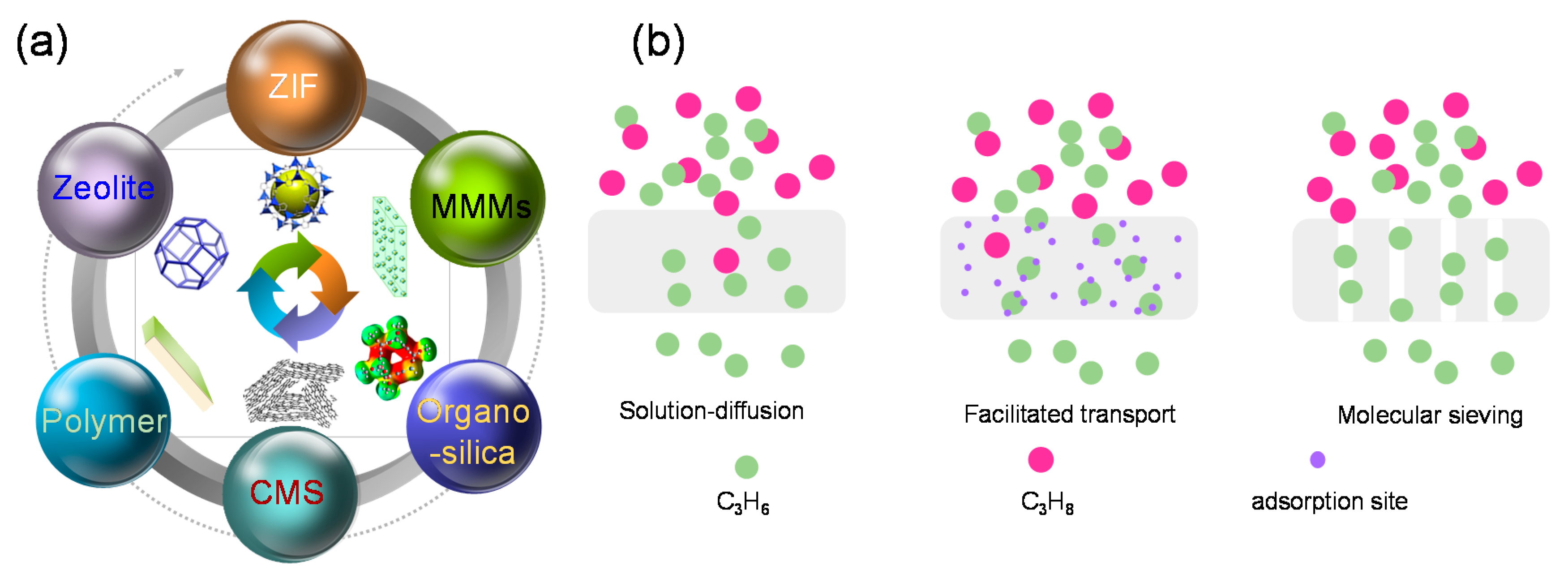
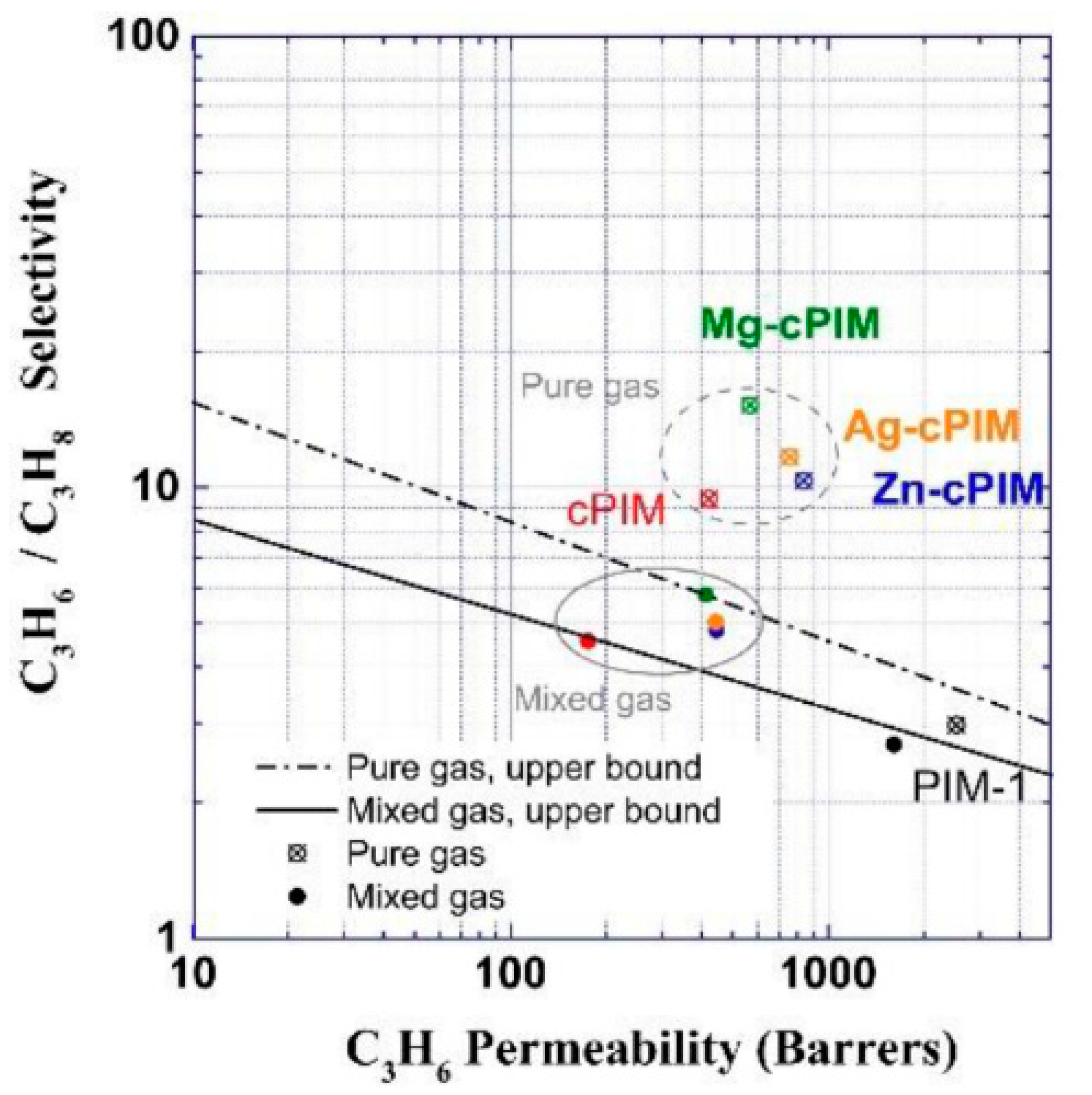

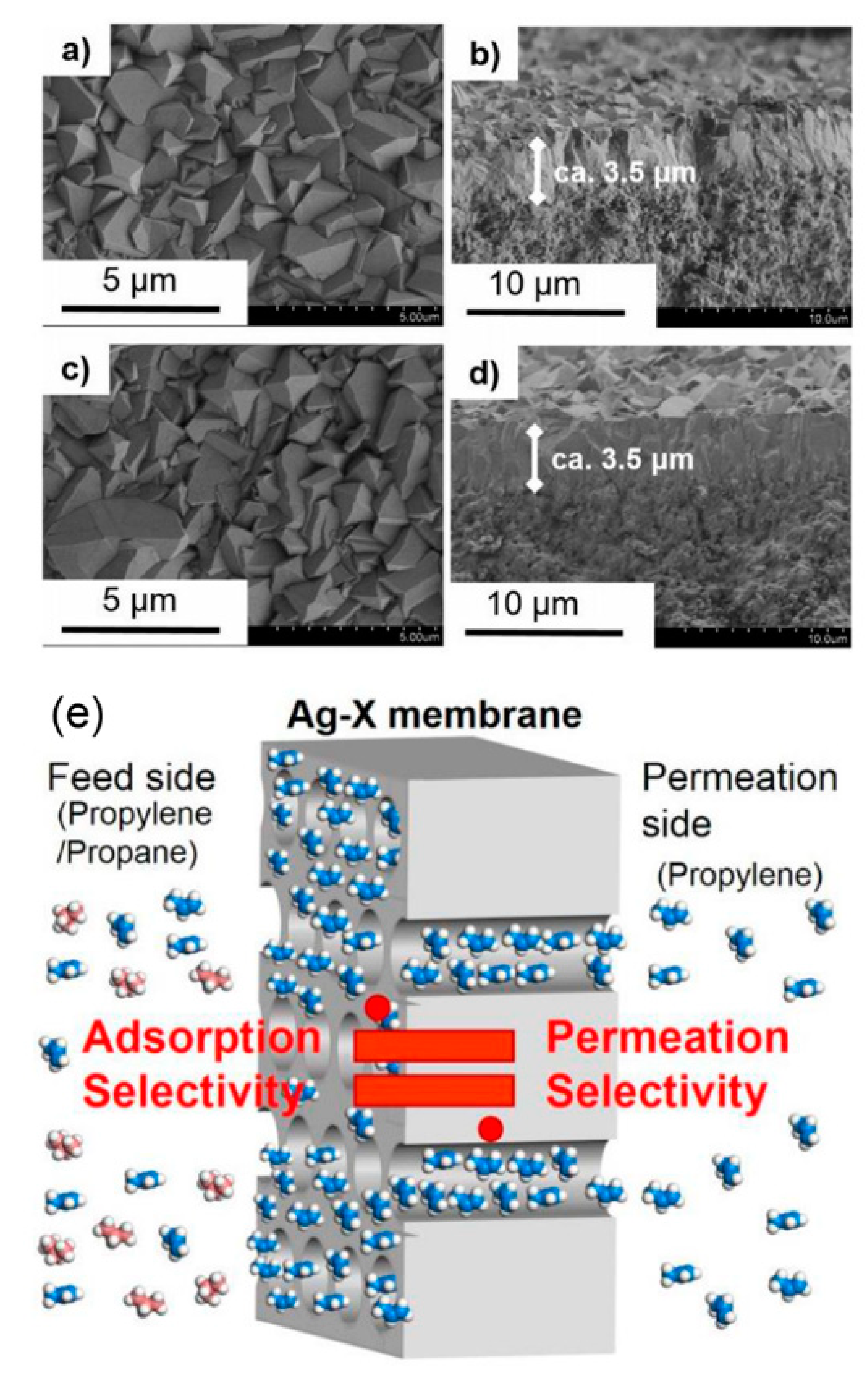
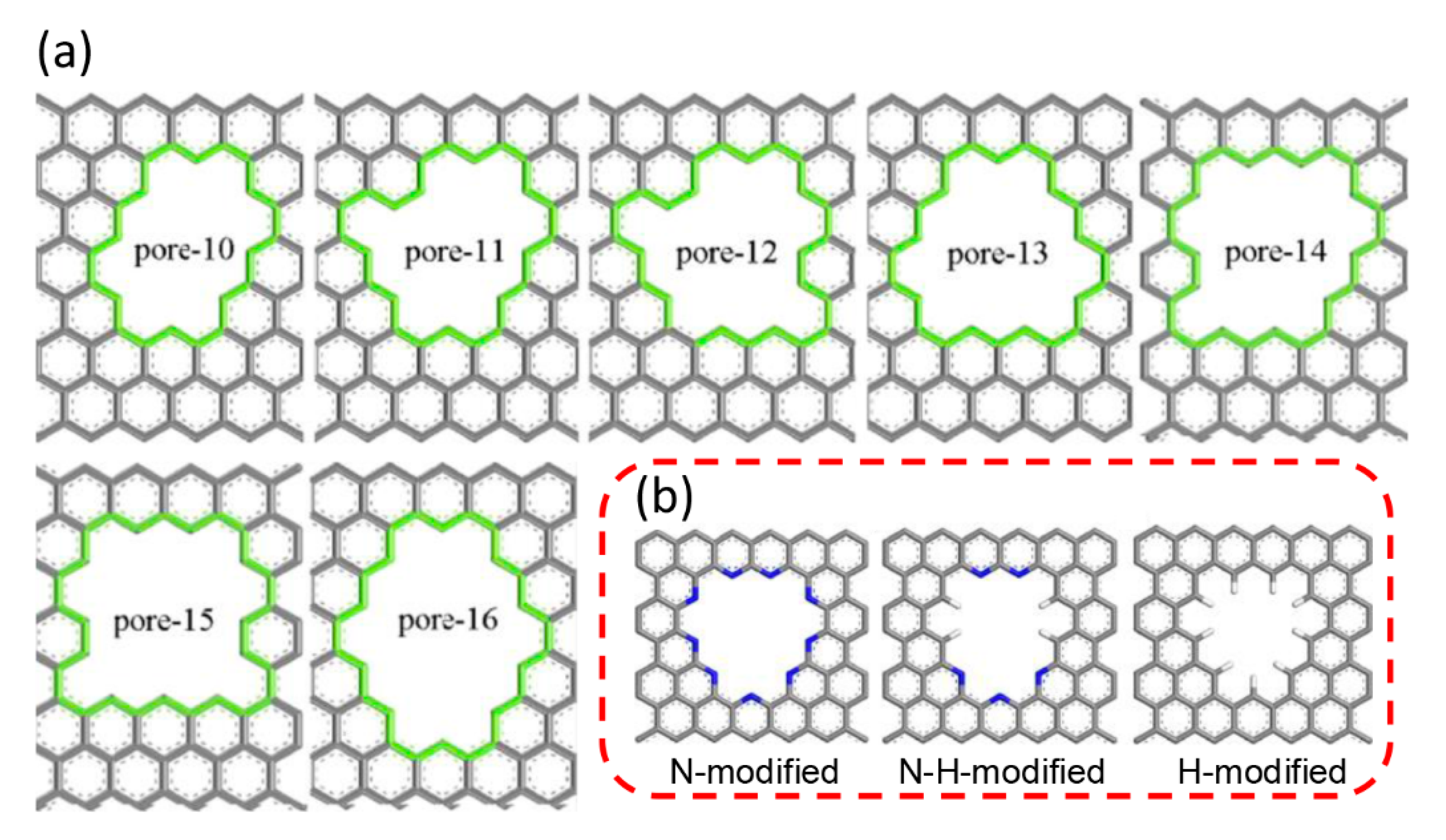
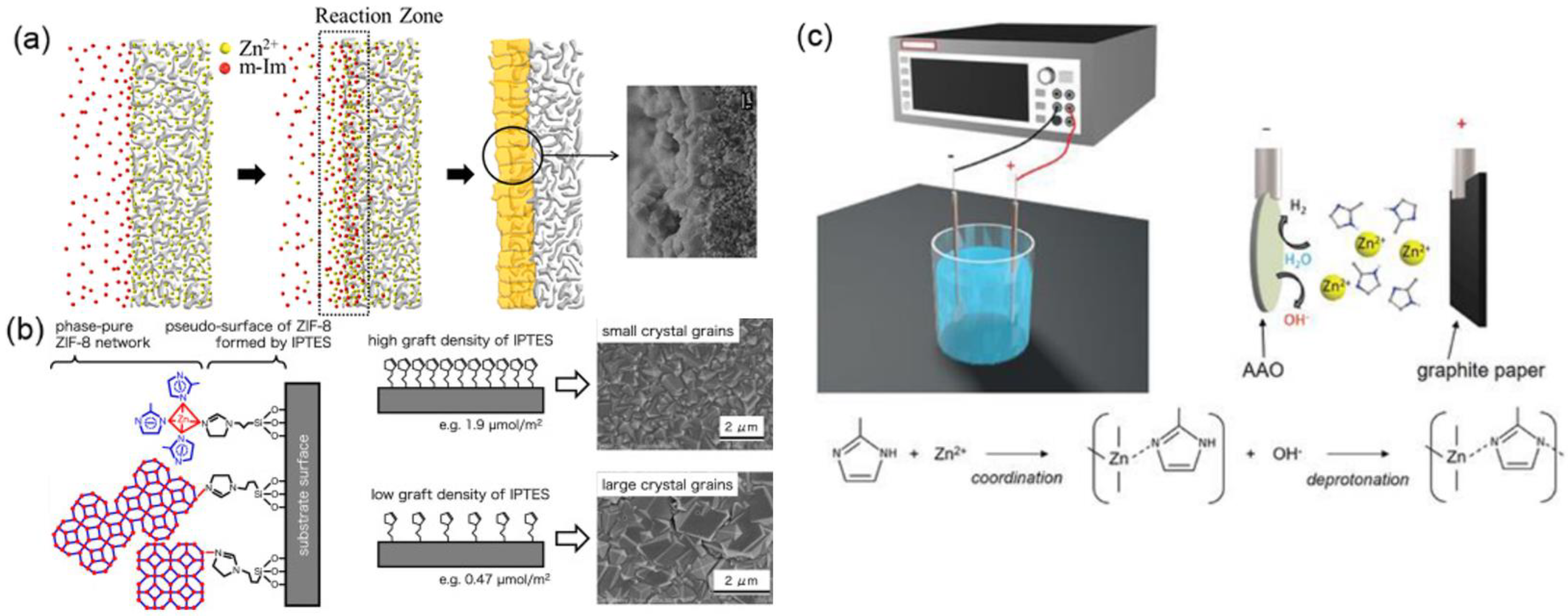




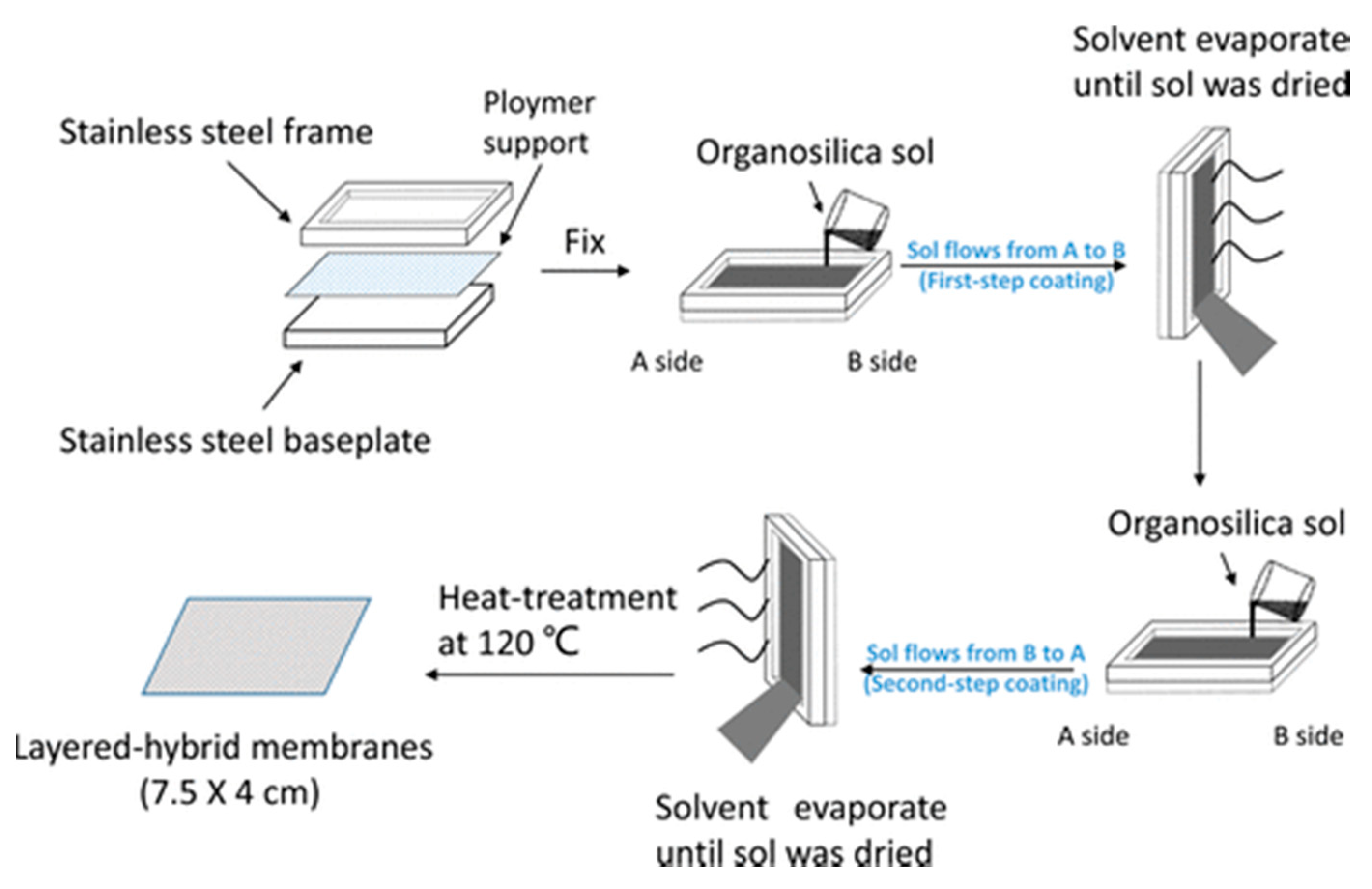
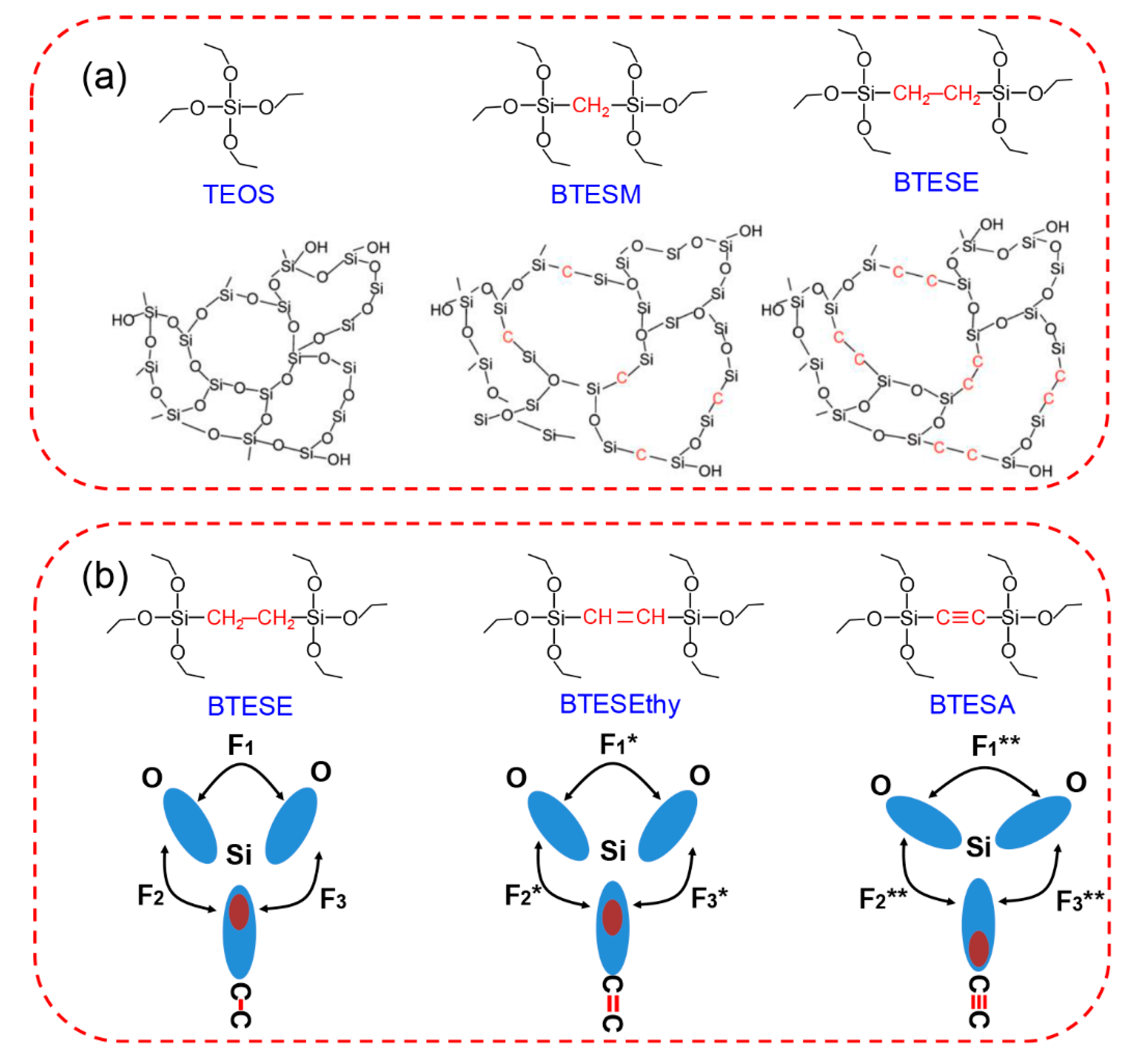
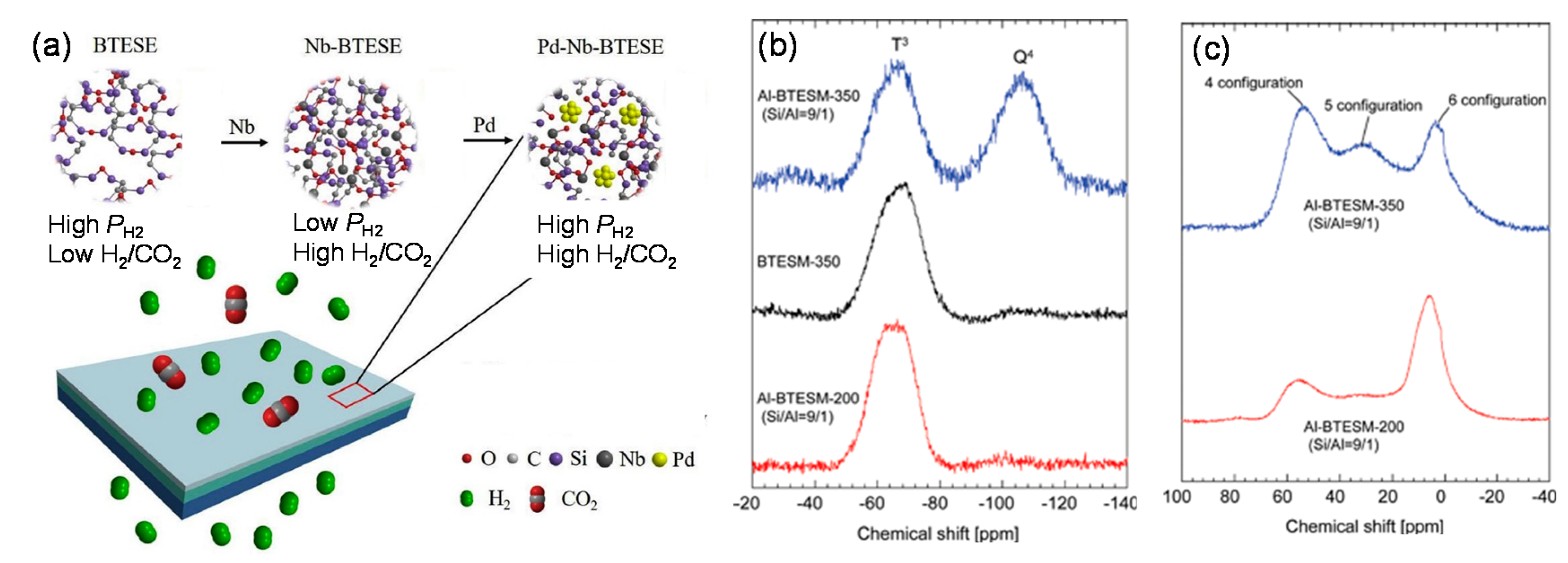
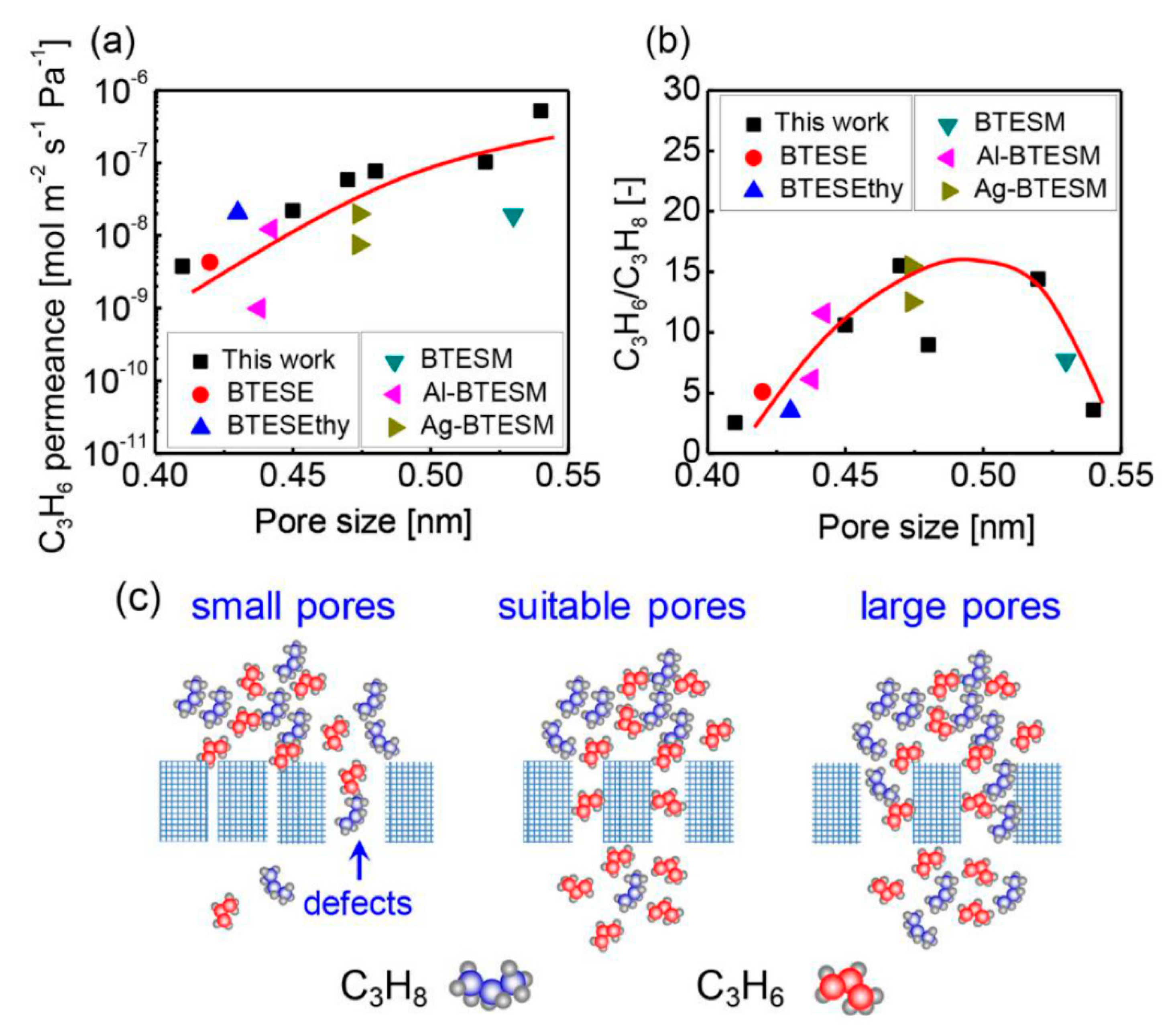
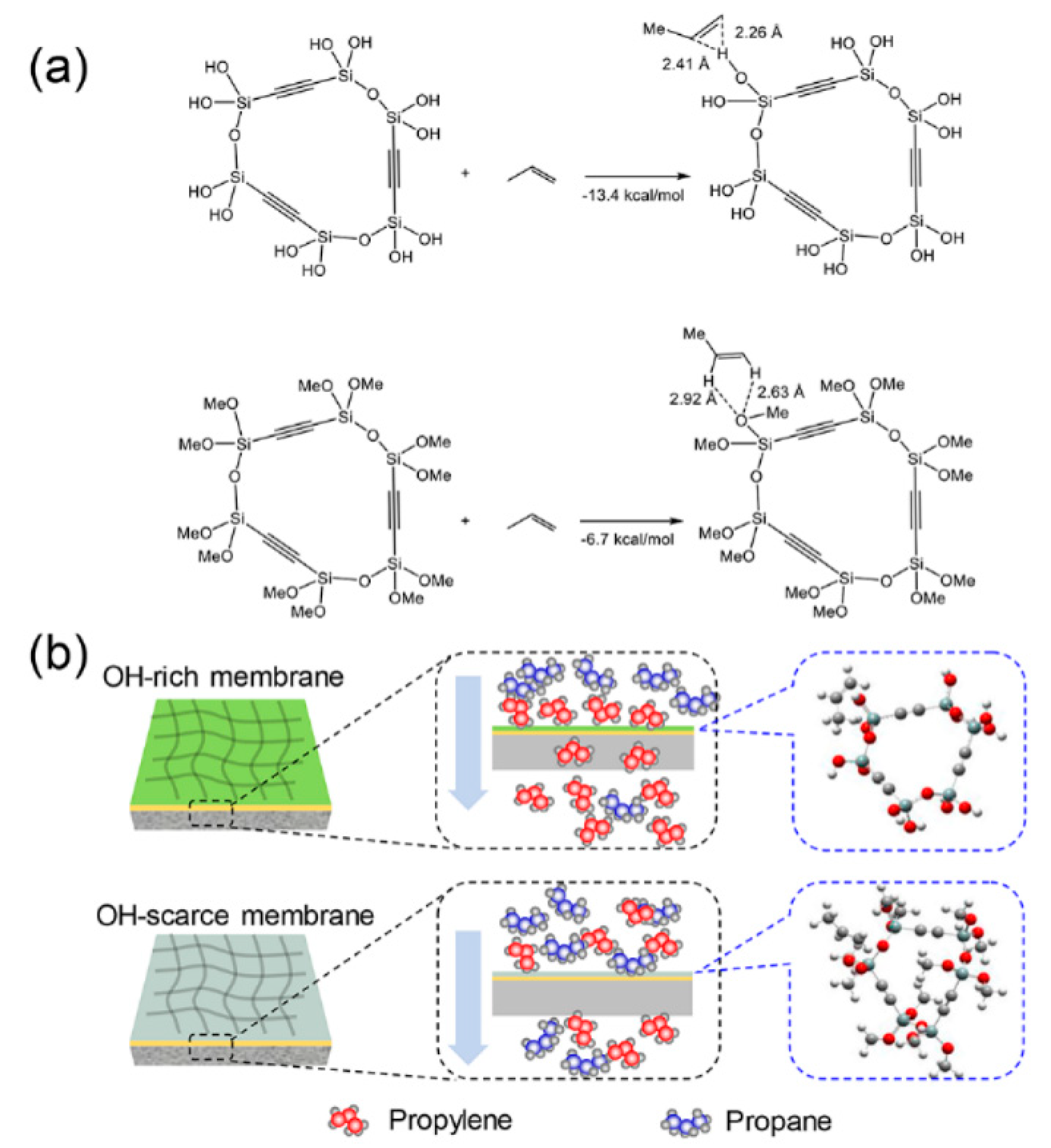

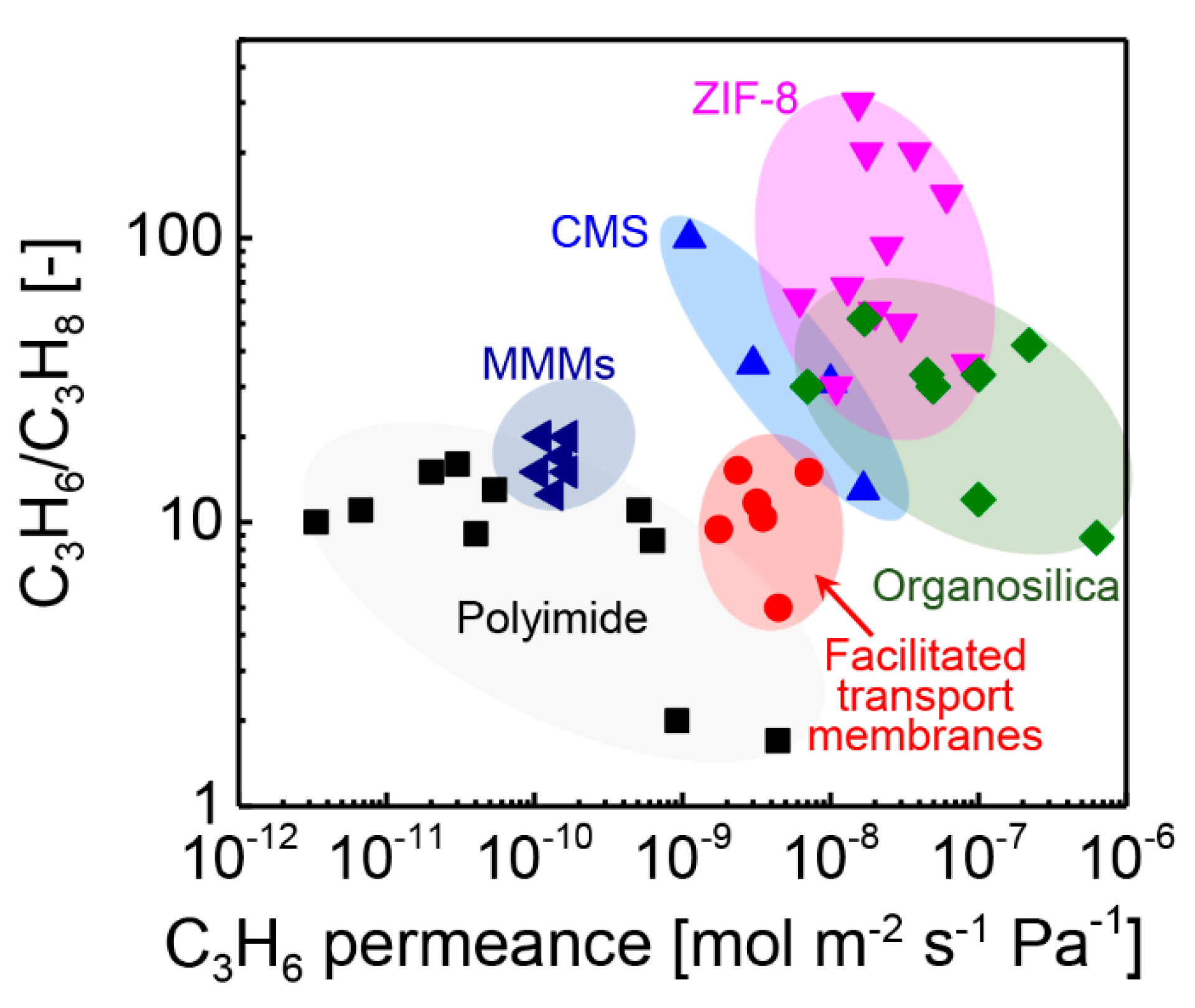
| Molecule | Kinetic Diameter [nm] | L-J Constant [nm] | Polarizability [1025 cm3] | Molecular Weight [g mol−1] | Boiling Temperature [°C] |
|---|---|---|---|---|---|
| C3H6 | 0.45 | 0.468 | 62.6 | 42.08 | −42.1 |
| C3H8 | 0.43 | 0.506 | 62.9~63.7 | 44.10 | −47.6 |
| Membrane | Thickness [μm] | Preparation Method | Feed Propylene Pressure | C3H6 Permeance [barrer] | C3H6/C3H8 Selectivity [-] | Temperature [°C] | Ref. |
|---|---|---|---|---|---|---|---|
| 6FDA | 20~30 | Casting | 0.38 | 0.38 | 13 | 35 | [20] |
| 6FDA | 20~30 | Casting | 1.30 | 0.48 | 12.8 | 35 | [20] |
| 6FDA | 20~30 | Casting | 1.85 | 0.66 | 8 | 35 | [20] |
| 6FDA | 20~30 | Casting | 2.02 | 0.68 | 7.2 | 35 | [20] |
| 6FDA a | 25.4 | Casting | - | 0.85 | 17 | 35 | [19] |
| KAUST-PI-1 a | 100 | Casting | - | 817 | 16 | 35 | [47] |
| Membrane | Thickness [μm] | C3H6 Permeability [barrer] | C3H6/C3H8 Selectivity [-] | Temperature [°C] | Ref. |
|---|---|---|---|---|---|
| cPIM | 70~90 | 421 | 9.42 | 35 | [22] |
| AgcPIM | 70~90 | 759 | 11.69 | 35 | [22] |
| MgcPIM | 70~90 | 568 | 15.23 | 35 | [22] |
| ZncPIM | 70~90 | 837 | 9.12 | 35 | [22] |
| Ag-ion gel membrane | 37.5 | 850 | 15 | 25 | [23] |
| Electronegativity of the Transition Metals | ||||||||
|---|---|---|---|---|---|---|---|---|
| Sc | Ti | V | Cr | Mn | Fe | Co | Ni | Cu |
| 1.4 | 1.5 | 1.6 | 1.7 | 1.6 | 1.8 | 1.9 | 1.9 | 1.9 |
| Y | Zr | Nb | Mo | Tc | Ru | Rh | Pd | Ag |
| 1.3 | 1.3 | 1.6 | 2.2 | 1.9 | 2.2 | 2.3 | 2.2 | 2.2 |
| La | Hf | Th | W | Re | Os | Ir | Pt | Au |
| 1.0 | 1.3 | 1.5 | 2.4 | 1.9 | 2.2 | 2.2 | 2.3 | 2.5 |
| Membrane Types | Characteristics | Disadvantages |
|---|---|---|
| CMS | CMS membranes are fabricated from the pyrolysis of microporous polymers. Good processability and molecular sieving properties [49]. | Fragile [50]. |
| Zeolite | Zeolite membranes are widely used based on the controllable pore size and strong adsorption properties [13]. | Grain boundary defects. Bad synthesis reproducibility [35]. |
| ZIFs | The zeolite-like structure endows the ZIFs materials with high thermal and chemical stabilities [15]. | High cost of membrane fabrication. Low reproducibility and scalability [15]. |
| Membrane | Thickness [μm] | Preparation Method | C3H6 Permeance [10−10 mol m−2 s−1 Pa−1] | C3H6/C3H8 Selectivity [-] | Temperature [°C] | Ref. |
|---|---|---|---|---|---|---|
| 6FDA | 1.6 | Dip-coating, pyrolysis | 30 | 36 | 25 | [52] |
| 6FDA | 0.52 | Dip-coating, pyrolysis | 100 | 31 | ~50 | [33] |
| BPDA-DDBT | 0.2 | Dip-coating, pyrolysis | 167 | 13 | 100 | [53] |
| 6FDA/BPDA-DAM | 35~60 | Casting, pyrolysis | 11.2 | 100 | 35 | [31] |
| Membrane | Thickness [μm] | Preparation Method | Measurement Method | C3H6 Permeance [10−10 mol m−2 s−1 Pa−1] | C3H6/C3H8 [-] | Temperature [°C] | Ref. |
|---|---|---|---|---|---|---|---|
| ZIF-8 | 2.2 | Seeded growth | W-K technique | 300 | 50 | −15 | [65] |
| ZIF-8 | 2.5 | Secondary growth | W-K technique | 110 | 30 | 35 | [72] |
| ZIF-8 | 1.5 | Counter diffusion | W-K technique | 200 | 55 | 25 | [17] |
| ZIF-8 a | 1 | seeding-free aqueous synthesis | - | 850 | 36 | 25 | [73] |
| ZIF-8 | 0.5 | aqueously cathodic deposition | W-K technique | 610 | 142 | 22 | [69] |
| ZIF-8 | 2.5 | hydrothermal synthesis | W-K technique | 62 | 61 | 22 | [66] |
| ZIF-8 | - | secondary growth | W-K technique | 240 | 93 | 35 | [74] |
| ZIF-8 | 2 | secondary growth | W-K technique | 130 | 67 | 35 | [75] |
| ZIF-8 | 0.2 | Fast current–driven synthesis | - | 154 | 300 | 25 | [67] |
| ZIF-67 | 0.7 | heteroepitaxially growing | W-K technique | 370 | 200 | 25 | [76] |
| ZIF-67 | 0.7 | Fast current–driven synthesis | - | 175 | 200 | 25 | [68] |
| Membrane Types | Characteristics | Disadvantages |
|---|---|---|
| General MMMs | The general MMMs are fabricated by combining molecular sieve materials with traditional polymers, obtaining the advantages from both the high porosity of molecular sieves and good processability of the polymers [13]. | The compatible issues between the inorganic filler and the polymer matrix. The permeability of membranes is still constrained by the matrix. |
| All nanoporous hybrid membranes | Both the filler and matrix are the nanoporous materials [30]. | No report at the present. |
| Membrane | Thickness [μm] | C3H6 Permeance [GPU] | C3H6/C3H8 Selectivity [-] | Ref. |
|---|---|---|---|---|
| Zr-fum-fcu-MOF/6FDA-DAM | 70 | 0.29~0.43 | 15~20 | [27] |
| ZIF-8/6FDA-DAM | - | 0.27 | 27.5 | [28] |
| ZIF-8/PIM-6FDA-OH | 40~60 | 0.5~0.75 | 31 | [29] |
| ZIF-8/MFI | 9 ± 3 | 61~68 | 146 ± 14 | [30] |
| ZIF-8/PIM-6FDA-OH | 0.75 | 2.17 | 20 | [77] |
| Membrane | Preparation Method | C3H6 Permeance [10−10 mol m−2 s−1 Pa−1] | C3H6 Permeance [GPU] | C3H6/C3H8 Selectivity [-] | Temperature [°C] | Ref. |
|---|---|---|---|---|---|---|
| BTESM a | Sol-gel, wipe coating | 6320 | 1888 | 8.8 | 50 | [89] |
| BTESM | Sol-gel, wipe coating | 495 | 142 | 30 | 50 | [98] |
| Al-BTESM a | Sol-gel, wipe coating | 70 | 20 | 30 | 50 | [97] |
| Ag-BTESM a | Sol-gel, wipe coating | 1000 | 287 | 33 | 50 | [99] |
| BTESA a | Sol-gel, wipe coating | 1000 | 287 | 12 | 50 | [93] |
| BTESA-B | Sol-gel, wipe coating | 450 | 134 | 33 | 50 | [101] |
| BTESA | Sol-gel, wipe coating | 170 | 51 | 52 | 50 | [45] |
| TEFS a | Sol-gel, wipe coating | 2200 | 657 | 42 | 35 | [118] |
Publisher’s Note: MDPI stays neutral with regard to jurisdictional claims in published maps and institutional affiliations. |
© 2021 by the authors. Licensee MDPI, Basel, Switzerland. This article is an open access article distributed under the terms and conditions of the Creative Commons Attribution (CC BY) license (https://creativecommons.org/licenses/by/4.0/).
Share and Cite
Guo, M.; Kanezashi, M. Recent Progress in a Membrane-Based Technique for Propylene/Propane Separation. Membranes 2021, 11, 310. https://doi.org/10.3390/membranes11050310
Guo M, Kanezashi M. Recent Progress in a Membrane-Based Technique for Propylene/Propane Separation. Membranes. 2021; 11(5):310. https://doi.org/10.3390/membranes11050310
Chicago/Turabian StyleGuo, Meng, and Masakoto Kanezashi. 2021. "Recent Progress in a Membrane-Based Technique for Propylene/Propane Separation" Membranes 11, no. 5: 310. https://doi.org/10.3390/membranes11050310
APA StyleGuo, M., & Kanezashi, M. (2021). Recent Progress in a Membrane-Based Technique for Propylene/Propane Separation. Membranes, 11(5), 310. https://doi.org/10.3390/membranes11050310






